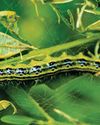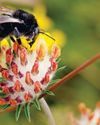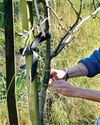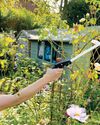
SOME trees need a summer trim to help protect them from a fungal disease. These varieties include plums and gages, edible and ornamental cherry varieties, apricots, peaches, nectarines, rhododendrons and laburnum.
They are cut back now, rather than when they are dormant like other deciduous fruiting trees such as apples and pears, because they are vulnerable to a common fungal problem called silver leaf disease.
This is caused by a fungus called Chondrostereum purpureum, the spores of which are most prevalent between September and May.
Because it is easily transmitted via wounds such as those caused by pruning, susceptible trees and shrubs are pruned when the risk is at its lowest.
Symptoms of silver leaf include the leaves developing a silvery sheen, dark stains when branches are cut open and, on dead branches, bracket fungi with a pale, woolly upper surface and a purple-brown undercarriage.
The main way of controlling the disease is to prune in summer when spores are less of a problem and wounds dry faster.
This story is from the {{IssueName}} edition of {{MagazineName}}.
Start your 7-day Magzter GOLD free trial to access thousands of curated premium stories, and 9,000+ magazines and newspapers.
Already a subscriber ? Sign In
This story is from the {{IssueName}} edition of {{MagazineName}}.
Start your 7-day Magzter GOLD free trial to access thousands of curated premium stories, and 9,000+ magazines and newspapers.
Already a subscriber? Sign In

To dig or not to dig?
Should we be carrying out a full dig on plots now? Bob considers the pros and cons of the 'autumn dig' debate

The box ball blues
As if his beleaguered box hadn't already taken a beating, Toby now has to deal with some hungry box caterpillars

Save your own seeds
Masterclass on: seed saving

Strange sightings
Three unusual insects turn up in Val's garden in one day

A bolt from the blue!
Cornflowers are perfect for garden and vase

Winter moth prevention
Ruth shows you how to avoid maggoty tree fruits

Create a winter container
There are as many options as in summer

Lightweight gardening tools
AS well as being good for our mental health, gardening is also great exercise.

Autumn price round-up
AG finds better bargains in lesser-known brands

Rudbeckias
Rudbeckias are ideal for sunny summer patios and borders, with some able to survive our coldest winters